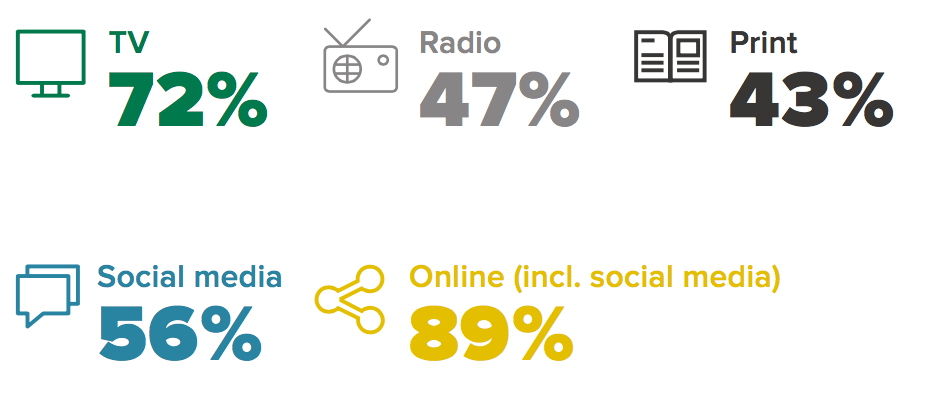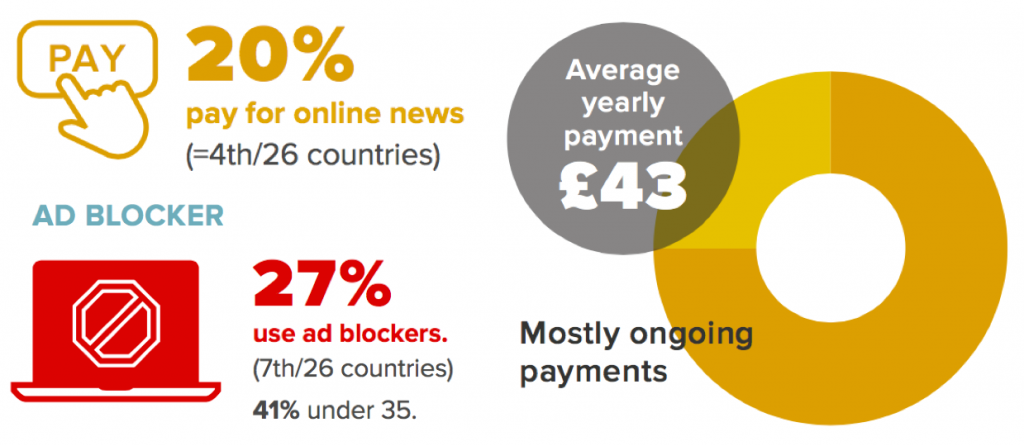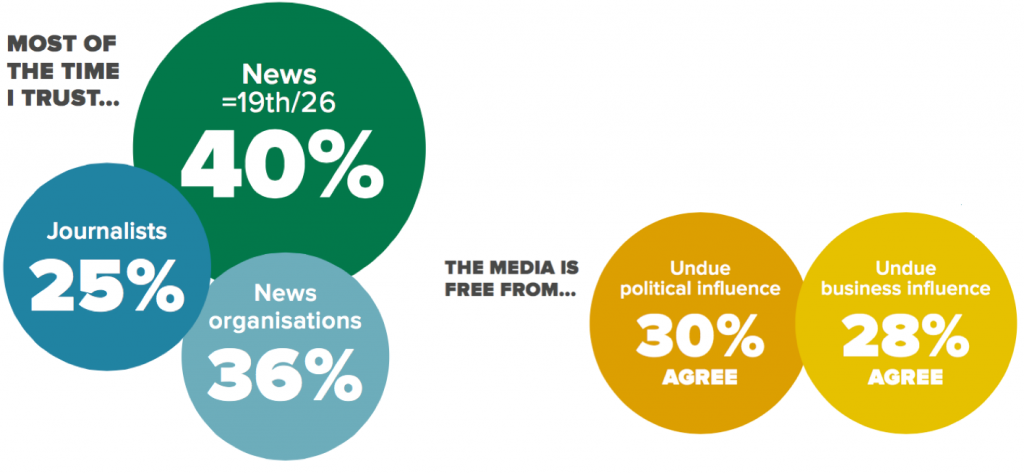| Statistics | |
| Population | 10m |
| Internet penetration | 95% |
The news ecology in Sweden has long been characterised by strong public service broadcasters and a large number of local quality newspapers, but is increasingly marked by weaker news organisations having much of their reach through mobile and social media.
Top Brands % Weekly Usage (TV, Radio and Print)
| Weekly use | Main source | |
|---|---|---|
| SVT news | 57% | 25% |
| TV4 news | 50% | 14% |
| SR news | 40% | 13% |
| Aftonbladet | 19% | 5% |
| Metro | 16% | 3% |
| A regional or local newspaper | 15% | 4% |
| Expressen | 14% | 1% |
| Dagens Nyheter | 13% | 3% |
| Svenska Dagbladet | 12% | 2% |
| Göteborgs-Posten | 9% | 2% |
| Dagens Industri | 8% | 1% |
| CNN | 8% | 1% |
| BBC News | 7% | 1% |
| Sydsvenska Dagbladet | 5% | 1% |
| Broadcasters/papers from outside Sweden | 4% | 1% |
| Uppsala Nya Tidning | 2% | 0% |
Top Brands % Weekly Usage (Online)
| Weekly use | Main source | |
|---|---|---|
| Aftonbladet online | 55% | 27% |
| Expressen online | 38% | 6% |
| Dagens Nyheter online | 25% | 6% |
| SR news online | 24% | 5% |
| Svenska Dagbladet online | 22% | 5% |
| TV4 news online | 21% | 4% |
| Regional or local paper website | 19% | 5% |
| Göteborgs-Posten online | 16% | 4% |
| Nyheter 24 | 16% | 1% |
| Dagens Industri online | 14% | 2% |
| SVT News Online | 13% | 2% |
| Sydsvenska Dagbladet online | 10% | 2% |
| Metro online | 10% | 1% |
| BBC News online | 8% | 1% |
| CNN online | 7% | 1% |
| MSN News | 6% | 1% |
Overview of key developments
By Oscar Westlund
Associate Professor, Department of Journalism, Media and Communication University of Gothenburg
In 2015 the three PSBs together received a total of around 8 billion Swedish krona (just under €1billion) in licence fees, with just a minor part being spent on news. The national television broadcaster TV4 continues to be one of the most financially successful in Scandinavia, improving its financial results by 3% at the same time as reducing its news output. Televised news from SVT and TV4 is still the most popular among Swedes, closely followed by online news.
The newspaper sector – the backbone of the Swedish news ecology – continued to lose circulation (down 6%) along with print advertising revenues (down 15%). Newspapers had a 15% share of the expanding advertising pie in 2015 (32.9 billion SEK/€3.5billion), with web and mobile now accounting for almost 40% of total spend.
Major newspaper titles are owned by large media companies/groups such as Bonnier (Dagens Nyheter and Expressen), Schibsted (Aftonbladet and Svenska Dagbladet), and Stampen Media Group (Göteborgs-Posten). Stampen, which owns a dozen newspapers and other media companies, showed the most dramatic financial improvement, reporting a profit of 66 million SEK/€7.2m in 2015, compared to a 2014 loss of 553 million SEK/€60m. However, Stampen remains burdened by debt and is struggling to survive. Mittmedia owns 28 newspapers and made a profit of 137 million SEK/€14m in 2015, yet has announced plans to cut 130 staff, including 90 journalists in the next few years. One key event in March 2015 was the closure of Mittmedia-owned newspaper Dagbladet, which had been in operation for 115 years, and was merged with another title Sundsvalls Tidning. There were also launches of online-only local news initiatives, such as Journalistik 24.
Swedish newspaper groups operate a variety of strategies to get people to pay for news online. Only newspapers within the Gota Media group require subscription for all original news content. Other newspapers such as Aftonbladet charge for specific premium content, with its so-called Plus subscription. Several newspapers also offer e-paper versions of their newspapers, with Dagens Nyheter, Göteborgs-Posten, and Svenska Dagbladet amongst the most successful in attracting subscribers. 1
A major concern for publishers has been the fast adoption of ad-blocking in Sweden (27%), one of the highest rates in our international survey (seventh place). In response 90% of publishers have signed up to a plan to collectively block all content from people using ad-blockers as part of a wider educational initiative about the damage that may be caused to journalism. 2 Aftonbladet and Expressen both have the majority of their online news accessed via mobile devices. Aftonbladet has held an uncontested number one position for online news since launching its news site in 1994: a result of substantial and consistent investment in online journalism – even during economic downturns. Schibsted-owned Omni is a popular mobile news website and app (10% reach) which aggregates news from Swedish and international news media.
Paying for news
Many newspapers have some form of paywall for online news, which helps explain why Sweden has one highest rates of payment (20%) in this year’s survey.
Trust
One possible explanation for relatively low trust scores is the growth in right-wing groups known for criticising legacy news media, and who are increasingly turning to so-called alternative media (e.g. social media). In other surveys, we see a significant gap between news media deemed trusted (typically SVT, SR, or a newspaper they personally subscribe to) and media that is not trusted (typically tabloid newspapers).
Scroll data area to see more
TOP SOCIAL NETWORKS*
| RANK | NETWORK | ALL | U35s |
|---|---|---|---|
| 1 | 42% | 43% | |
| 2 | YouTube | 11% | 13% |
| 3 | 8% | 10% | |
| 4 | 5% | 6% | |
| 5 | 3% | 3% |
- Medieborgarna & medierna: En digital värld av rättigheter, skyldigheter – möjligheter och ansvar. Stockholm: Elanders, SOU 2015: 94. ↩
- https://digiday.com/uk/swedens-publishers-gearing-block-ad-blockers/
A key finding in the survey data is that Swedes – alongside the populations of South Korea and Switzerland – turn to their smartphone for news more than computers. This is partly because Swedish legacy news media have been developing mobile news services, sites, and applications for many years. [39. O. Westlund, ’Mobile News: A Review and Model of Journalism in an Age of Mobile Media’, Digital Journalism, 1/1 (2013): 6–26. ↩




